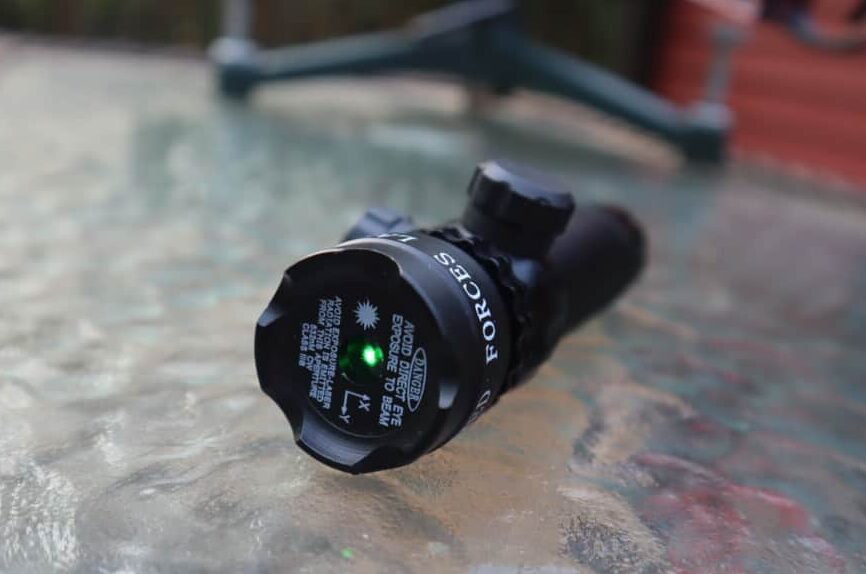Your gun typically comes with a bare bones sight line consisting of a narrow trough with colored dots on each side. You line up the front and back sights to get an idea of where the bullet will fly when you squeeze the trigger.
Reasons to Use a Laser Sight
When you have learned the basics of shooting and you are ready focus on increasing your accuracy, it is time to consider a laser sight.
- Laser sights are useful as a training aid
- Laser sights allow you to find your target quickly
- Laser sights improve target acquisition in low light situations
- Laser sights give you a tactical advantage in a defensive situation
- An assailant with a red or green laser projected onto his chest knows you mean business
Disadvantages of Laser Sights
- In a self defense situation, the laser sight may give away your location
- Laser sights use batteries quickly
- Laser sights add to the weight and bulk of your gun
- You need to take the laser sight into account when choosing your holster
- Improper training with the laser sight may lead to lazy sighting habits
The Types of Laser Sights
Laser sights can produce red or green light. They may be attached to the grip or mounted under the rail of a handgun. You can replace your handgun grip with a grip that includes a laser sight.
Laser sights can be attached to the saddle of your shotgun or the rail of your AK or AR style rifle.
You can choose between laser sights that turn on when you attach them to the gun and laser sights that switch on and off. Your laser sights can be activated at the front, rear, or side, or ambidextrously at either side. Battery life is generally two to four hours, so don’t just leave it on.
.jpg?sw=1000&sh=1000)

How To Use a Laser Sight Correctly
To use a laser sight, start by lining up the sights that came with the gun. When you look down the iron sights with the laser on, you should see the red or green beam right between the posts of the rear sight.
Adjust the windage and elevation settings on your laser sight until the red or green beam hits the target in line with the iron sights.
Now shoot a few rounds at the target, aiming at a particular spot. Check the distribution of the bullet holes. Did they stay right in the middle? Your laser sight is lined up correctly.
Did your bullets stray to the right or left, top or bottom? Adjust the windage to compensate for right or left and elevation to for high or low shots. Shoot a few more rounds. Keep adjusting until your sights and the laser sight are aligned.
Avoid Common Mistakes People Make With Laser Sights
- Laser sights do not replace your gun’s sights; you still need to sight in the shot with the gun at eye level.
- Laser sights are not at the correct windage and elevation straight out of the box; you have to adjust them
- Using laser sights will not compensate for lack of practice; user error still factors in
- Laser sights use batteries quickly, so make sure the laser is off when you finish your practice session
- Never shine a laser into anyone’s eyes; you can cause lasting damage
- Don’t forget that the laser is attached to a gun; always obey gun safety rules while using the laser
- Don’t lose the element of surprise in a self-defense situation by turning on your laser if the assailant hasn’t spotted your location
Choose the Right Laser Sight
With so many choices, how do you narrow down the right choice for your situation? Let’s look at the options.
Grip Mounted Laser Sight
Mounting a laser sight on your existing grip adds functionality without having to give up the grip that is already on your gun. It adds a little bulk, so be sure the holster you choose can accommodate the added mass.
Grip Replacement Laser Sight
Replacing the grip with an integrated laser sight grip gives you the opportunity to upgrade your grip while choosing a laser sight. This also keeps bulk to a minimum, but make sure your holster is designed for the grip you choose.
Laser Sight Mounted under the Rail of Your Handgun
The rail mounted laser sight is easy to add and remove, and it doesn’t change the way the gun feels in your hand. This is the way to use a laser sight if you want to use it on several guns interchangeably.
Trigger Guard Mounted Laser Sight
Like the rail mounted laser sight, the trigger guard mount keeps the bulk at the front of the gun rather than in the palm of your hand. As with all the laser sights, make sure your holster is designed to accommodate the extra bulk.
Saddle Mounted Laser Sight
Shotguns can also use a laser sight. You mount it on the saddle, just above the trigger.
Rail Mounted Laser Sights for your AK or AR Style Rifle

You can mount a laser sight on the accessory rail of your AR or AK style rifle to make shooting it even easier and more fun without changing the way it fits in your hand.
Red Versus Green Laser Sights
Which color you prefer depends on how you plan to use the gun. Green laser is better for bright conditions. Both colors show up well at night. Red tends to be less expensive.
Instinctive Activation Versus On and Off Switch
You can get laser lights that turn on when you grip the gun. Make sure this kind includes the ability to turn it off manually just in case you need to keep your location a secret.
You can buy laser sights that switch on and off. This is preferable if you will have the laser sight on your gun all the time. Just don’t forget to switch it off after each use.
The Location of the Activation on Your Laser Sight
Saddle mounted laser sight tend to have the activation switch on the side. Trigger guard mounts are likely to activate with a front switch.
The Last Word
Used for their intended purpose, laser sights are an excellent addition to your gun. Have fun exploring the options. If you know someone who has a laser sight, see if you can visit the range and get a feel for which type of laser sight would suit you.
Keep reading my blog for more helpful information. Watch our Double Eagle Gunworks YouTube channel for information videos on gun topics.


